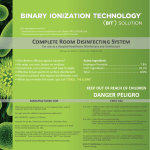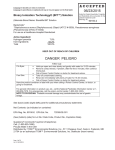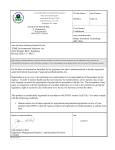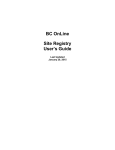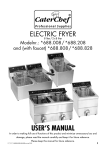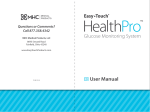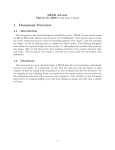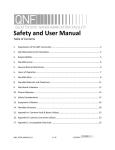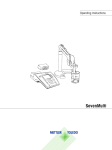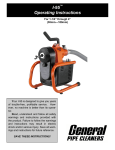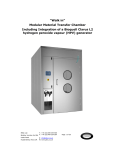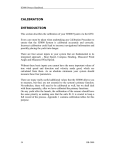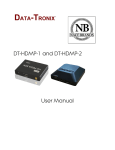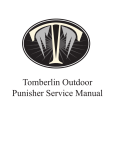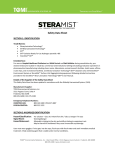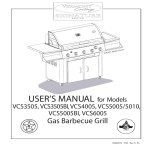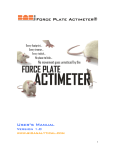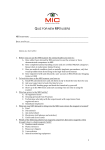Download View Product Label - KellySolutions.com
Transcript
BINARY IONIZATION TECHNOLOGY (BIT ) SOLUTION ® ™ Kills pathogenic bacteria Staphylococcus aureus (Staphylococcus) (Staph) (ATCC # 6538) and Pseudomonas aeruginosa (Pseudomonas) (ATCC # 15442) C������� R��� D����������� S����� For use as a Hospital-Healthcare Disinfectant EPA Reg. No. 90150-2 | EPA Est. No. 72038-DE-001 Active Ingredient: • Disinfection efficacy against bacteria Hydrogen Peroxide ........................................ 7.8% • No wipe, no rinse, leaves no residues Inert Ingredients .......................................... 92.2% • Economical, non-corrosive, and easy to apply Total .............................................................. 100% • Effective broad-spectrum surface disinfection • Reaches surfaces that regular disinfectants can’t • When you re-enter the room, you can “SMELL THE CLEAN” MANUFACTURED BY TOMI Environmental Solutions, Inc. | 5111 Pegasus Court, Suite A Frederick, MD 21704 | 800.525.1698 | www.tomiesinc.com NET CONTENTS: 1 gallon / 3.79 liters See fold out for Lot No./ Data Code, Product No., Expiration Date FIRST AID If in eyes • Hold eye open and rinse slowly and gently with water for 15-20 minutes. • Remove contact lenses, if present, after the first 5 minutes, then continue rinsing eye. • Call a poison control center or doctor for treatment advice. Binary Ionization Technology® (BIT™) is a licensed trademark of TOMI Environmental Solutions, Inc. USA If on skin • Take off contaminated clothing. • Rinse skin immeadiately with plenty of water for 15-20 minutes. • Call a poison control center or doctor for treatment advice. Use product only with SteraMist™ Environment System or SteraMist™ Surface Unit fogging/misting equipment following detailed instructions provided in the SteraMist™ Binary Ionization Technology® (BIT™) User Manual. Have the product container or label with you when calling a Poison Control Center, or doctor, or going for treatment. Patented Activated Ionized Hydrogen Peroxide (AIHP) technology For general information on product use, etc., call the National Pesticides Information Center at 1-800-858-7378. For emergencies, call the poison control center (1-800-222-1222). NOTE TO PHYSICIAN: Probable mucosal damage may contraindicate the use of gastric lavage. MISCELLANEOUS CLAIMS • SteraMist™ Surface Unit provides a fully portable, hand-held, point and spray application • SteraMist™ Surface Unit is applied in five seconds per square foot with a seven-minute contact time to disinfect • No Wipe, No rinse • When you re-enter the room, you can “smell the clean” • [Allows for] quick room turnover • Easily incorporated into (current) cleaning procedures • Leaves (room) surfaces disinfected • Makes whole room disinfecting easier • Lightweight, easy to transport, and capable of achieving reliable disinfection • Self-contained, allowing for reliable disinfection • Easy to transport and can be configured to treat multiple spaces simultaneously • Scalable technology - able to use multiple units/applicators • Economical, (non-corrosive), and easy to apply • Disinfection efficacy against bacteria* • For use in SteraMist™ (Binary Ionization Technology® (BIT™)) (fogging) (Environment System) (Surface Unit) (equipment) (by a trained technician) • For use in SteraMist™ (Binary Ionization Technology® (BIT™)) (Environment System) (Surface Unit) (room) (handheld) (fogging equipment) (instruments) (device (s)) (fogger (s)) system(s) • Healthcare (Hospital) disinfectant • Ready-to-use (formula) (no mixing required) • Go (Goes) above, beyond, under and around disinfecting sprays and wipes • Disinfects hard to reach hard non-porous surfaces in treated room. • Disinfects high touch hard non-porous surfaces (in treated room) • SteraMist™ Surface Unit disinfects treated hard non-porous surfaces on high touch equipment • SteraMist™ Surface Unit disinfects hard non-porous high touch surfaces • Patented Technology • Leaves no residues (no wiping necessary) • Active ingredient exclusively hydrogen peroxide • [Economical and] easy to apply • Whole (complete) Room Disinfection (Disinfecting) (Disinfectant) (System) • Bleach (Chlorine) (Bleach and Chlorine) free formula (disinfection) (disinfecting) (disinfectant) • Easy, Effective • Frequent (daily) use formula • Great (suitable) for frequent (daily) use • No (mixing) (or) (dilution) (diluting) required • Room is safe to enter within minutes following aeration, once hydrogen peroxide is below 1 ppm • Effective whole (complete) room treatment time of just over 75 minutes (including application time, contact time, and aeration time) • Efficient whole (complete) room treatment time of just over 75 minutes (including application time, contact time, and aeration time) allows for quick room (disinfection) (and) (turnover) • 5-second direct application per square foot with the SteraMist™ Surface Unit • Patented Activated Ionized Hydrogen Peroxide (AIHP) technology GENERAL PRODUCT PERFORMANCE/USAGE CLAIMS • Reaches surfaces that regular disinfectants can’t • Disinfection efficacy against bacteria • Room fogger works to disinfect microorganisms* in even the most hard-toreach areas • Reduce(s) risk of cross contamination associated with contaminated surfaces • Reduce(s) labor costs Effectively eliminates (pathogens*) (bacteria*) from hard, nonporous surfaces • Effective broad-spectrum surface disinfectant • Intended for use in all (medical), (healthcare,) (clinical), (semi-critical care) and (long term care) facilities • Gets everywhere, disinfects pre-cleaned, hard, non-porous room surfaces • (Disinfectant) (Disinfects) (Daily) (Multi-purpose) (Multi-room) (Multi-surface) • Kills pathogenic bacteria* • Controls odor causing bacteria • Deodorizes by killing odor causing bacteria • Eliminates (Removes) odor causing bacteria • Gets rid of odors by killing the (bacteria) (that cause them) • Helps prevent the build-up of odors by killing odor-causing bacteria (on hard; pre-cleaned, non-porous surfaces) • Disinfects hard pre-cleaned, non-porous, (non-food) contact surfaces in: (use sites) • For (hospital) (healthcare) (medical) (semi-critical care) (long term care) facilities as a disinfectant • For use on hard, pre-cleaned, non-porous surfaces located in: (use sites) • Great (suitable) for whole (complete) room (disinfecting) (disinfection) • Use on hard to reach areas • Use this product in (use sites listed here) SPECIFIC DISINFECTING CLAIMS • Effective against Bacteria* • Disinfection of all hard non-porous surfaces in a hospital (patient) room • (Disinfectant) (Disinfecting) fogging (formula) (product) for (whole) (complete) room surface (disinfection) (disinfecting) • An effective disinfectant (formula) (product) for use in healthcare facilities • An effective disinfectant (formula) (product) for use in healthcare facilities for (whole) (complete) room surface (disinfection) (disinfecting) • An effective disinfectant (solution) (formula) (product) for use in (hospitals) (healthcare) (medical) (semi-critical care) (long term care) facilities • An effective disinfectant (solution) (formula) (product) for use in (hospitals) (healthcare) (medical) (semi-critical care) (long term care) facilities for whole (complete) room surface disinfection (disinfecting) • Effective against bacteria* • Kills (eliminates) (destroys) (bacteria*) on hard, non-porous surfaces • Kills (eliminates) bacteria* (odors) and deodorizes • On hard, pre-cleaned, non-porous, non-food contact surfaces this product kills (eliminates) bacteria* • Surface Disinfectant • Whole (Complete) Room Surface Disinfectant • This product reduces the risk of cross contamination of bacteria* on hard, pre-cleaned, non-porous surfaces • This product (helps) (aids) in the reduction of cross contamination of bacteria* on hard, pre-cleaned, nonporous surfaces • Use this product in places that are difficult to (disinfect) (reach) • (This product) kills the bacteria* that cause (bad) odors • (This product) kills bacteria* on hard non porous, nonfood contact surfaces in public places • (This product) kills bacteria* on commonly touched on hard non-porous, non-food contact surfaces (in non-residential public places) (in hotel rooms) (in medical facilities) *Staphylococcus aureus (Staphylococcus) (Staph) (ATCC # 6538) and Pseudomonas aeruginosa (Pseudomonas) (ATCC # 15442) HEALTHCARE USE SITES (This product) (Binary Ionization Technology® (BIT™) Solution) is designed specifically as a (hospital) (healthcare) (ready-to-use) disinfectant (disinfecting) fogging (formula) (product) for use in the following settings: Including but not limited to: • • • • • • • • • • • • • • • • • • • • • • • • Ambulatory Surgical Centers (ASC) Anesthesia Rooms or Areas (Assisted Living or Full Care) Nursing Homes CAT Laboratories Central Service Areas Central Supply Rooms or Areas Critical Care Units or CCUs Dental operatories Dentist office Elevators Examination room(s) Dialysis Clinics (Facilities) Donation Centers (blood) (plasma) (semen) (milk) (apheresis) Emergency Rooms or ERs Eye Surgical Centers Health Care Settings or Facilities (Hospital) Kitchens (non-food contact surfaces) Hospices Intensive Care Units ICU(s) (areas) Isolation Areas Laundry Rooms Laboratories Long Term Care Facilities Medical Facilities • • • • • • • • • • • • • • • • • • • • • Newborn or Neonatal (Nurseries) (Intensive Care) Units (NICU) Nursing or Nursing Stations Operating Rooms or ORs Ophthalmic Offices Orthopedics Out Patient (Surgical Centers (OPSC)) (Clinics) (Facilities) Patient Areas Patient Restrooms (Pediatric) Examination Rooms or Areas Pediatric Intensive Care Units (PICU) Pharmacies Physical Therapy Rooms or Areas Psychiatric Facilities Public (Care) Areas Radiology or X-Ray Rooms or Areas Recovery Rooms Rehabilitation Centers Respiratory Therapy Rooms or Areas Restrooms Surgery Rooms or Operating Rooms or ORs Waiting Rooms or Areas OTHER USE SITES Animal Industry, Bio-Safety labs, Biotech Industry, Commercial, Education, Entertainment, Government, Historic Buildings, Homeland Defense, Hospitality, Industrial, Institutional, Multifamily housing, Military, Pharmaceutical, Recreational, Entertainment and Residential Settings and Assets, Senior Living, Tissue banks, Transportation (public and private), Worship Facilities. SPECIFIC AREAS OF USE INCLUDE Airplane, Ambulance, Automobile, Barrier isolator, Biological Decontamination Chamber, Biological Safety Cabinet, Blood Bank, Boat, Bowling Alley, Brothel, Bus, Cargo Planes, Campground Facility, Church (Temple) (Mosque) (House of worship), Clean Room (Electronic) (Pharmaceutical) (Tissue Bank), Clinic (Medical), College or University Facility, Commercial Building, Correctional Facility, Cruise Ship, Day Care Center, Dorm, Factory, Gymnasium, Health Club (Spa), Home, Hospital, Hotel, Industrial Facility, Infirmary, Institutional Facility, Laundromat (Institutional), Locker Room, Manufacturing Plant (non-food), Massage Therapy Facility, Military (Installation) (Vessel) (Aircraft) (Vehicle) (Asset), Mobile Home, Motel, Nursing Home, Office (Medical, Dental, Physician’s, Commercial, Correctional, Sheriff), Pharmaceutical Test and Manufacturing Facility, Pharmacy, Indoor Playground, Police Department, Public Facilities, Public Restroom, Recreational Center, Rental Facility, Residential Facility, Retail Facility, Recreational Vehicle, School Bus, Schools, Shelter, Sports Arena, Submarine, Theaters, Tissue Bank, Train, Veterinary Clinic, Vivarium, and Warehouse. FOOD HANDLING USE SITES (INCLUDES STORAGE, PREPARATION, PROCESSING, AND SERVING) Food Manufacturing Plant, Food Handling Establishments, Food warehouses, Cafeteria, Farmer’s Market, Food Service Establishment (Restaurant) (Fast food), Supermarket or Grocery Store FOOD AREAS In establishments where food and food products are held, prepared, processed and served, application may be made only when the facility is not in operation provided exposed food is covered or removed from the area being treated prior to application. Food contact surfaces must be rinsed with potable water after use of the product. Food areas include areas for receiving, storage, packing (canning, bottling, wrapping, boxing), preparing, edible waste storage, enclosed processing systems (mills, dairies, edible oils, syrups), serving areas (where prepared foods are served, such as dining rooms). NON-FOOD AREAS This product may be used to treat nonfood areas in food handling use sites. Nonfood areas include garbage rooms, lavatories, entries and vestibules, offices, locker rooms, machine rooms, boiler rooms, garages, mop closets, and storage (after canning or bottling). GENERAL INFORMATION - BINARY IONIZATION TECHNOLOGY® (BIT™) SOLUTION SITE-SPECIFIC GUIDANCE FOR PREPARATION OF A HOSPITAL DISINFECTION MANAGEMENT PLAN The Binary Ionization Technology® (BIT™) Solution is for use exclusively with the SteraMist™ Environment System and the SteraMist™ Surface Unit for hospital disinfection of rooms. Review the SteraMist™ User Manuals for proper instructions on how to operate the SteraMist™ Environment System and SteraMist™ Surface Unit prior to utilizing the equipment for disinfecting areas. SteraMist™ Binary Ionization Technology® (BIT™) Solution should be applied by properly trained personnel who are thoroughly trained in the use, safety, and operation of the SteraMist™ Environment System and SteraMist™ Surface Unit and Binary Ionization Technology® (BIT™) Solution Application Process, exclusively using Binary Ionization Technology® (BIT™) Solution and who have received a Certificate of Completion of the SteraMist™ Technician Training course from TOMI™ Environmental Solutions. The TOMI™ Environmental Solutions, Inc. trained personnel are responsible for working with the owners and/or the responsible employees of the site that is undergoing Binary Ionization Technology® (BIT™) Solution treatment to develop a site-specific Hospital Disinfectant Management Plan (HDMP) for each site that will be treated with Binary Ionization Technology® (BIT™) Solution. Trained personnel are responsible for all tasks of the disinfection processes unless otherwise noted in the HDMP and must be on site for the entire disinfection treatment process. The HDMP must address characterization of the site, and include appropriate monitoring and notification requirements, consistent with, but not limited to, the following: Binary Ionization Technology® (BIT™) Solution is for use as a hospital disinfectant on hard non-porous surfaces, and is not intended for use on textiles or hard porous surfaces. Binary Ionization Technology® (BIT™) Solution has been registered with TOMI™ Environmental Solutions, Inc. in accordance with Federal Regulations for the specific uses described on the product label, in this package insert, and the SteraMist™ User Manuals. Uses other than what is specified and described in these materials are not permitted. The instructions that follow explain how to define appropriate use conditions for use in dry, pre-cleaned spaces. Using the SteraMist™ Environment System, this includes sealed enclosures in industrial, commercial, and institutional settings (including production operations in pharmaceutical manufacturing, manufacturing clean rooms, laboratories, animal research facilities, hotel rooms, offices, cruise ships and recreational facilities, and all other use sites as detailed in the SteraMist™ Environment System User Manual). Using the SteraMist™ Surface Unit, all use site surfaces may be treated without isolation/sealed enclosures. Effective application of Binary Ionization Technology® (BIT™) Solution requires adequate Activated Ionized Hydrogen Peroxide (AIHP) concentration and exposure time. The process parameters are controlled through the use of appropriate monitoring instruments. See the SteraMist™ User Manual prior to initiating the application process to determine the appropriate steps to take in development and application of the process. For additional guidance, in-service, and training on how to develop and monitor custom cycles, contact TOMI™ Environmental Solutions, Inc. BINARY IONIZATION TECHNOLOGY® (BIT™) SOLUTION APPLICATION PROCESS The SteraMist™ Binary Ionization Technology® (BIT™) Solution is applied through the SteraMist™ Environment System or the SteraMist™ Surface Unit (SteraMist™) for the required time to maintain the desired concentration of Activated Ionized Hydrogen Peroxide (AIHP). The Binary Ionization Technology® (BIT™) Solution fog quickly is broken down into water (humidity) and oxygen. The BIT™ process consists of four phases: PREPARATION PHASE – Develop Hospital Disinfectant Treatment Plan reviewing the user safety requirements and PPE on the label and using guidance in Section 4. Make sure areas to be treated are pre-cleaned and are dry and free of visible biofilm. When using the SteraMist™ Environment System, sealing the space will allow for a faster concentration of AIHP. APPLICATION PHASE - The Binary Ionization Technology® (BIT™) Solution will flow through the Atmospheric Cold Plasma Arc in the nozzle, convert into AIHP, and is introduced into the air stream. The APPLICATION phase facilitates concentration of AIHP in the treatment area. APPLICATION time will be determined by the number of application nozzles used, enclosure materials, environmental conditions, and treatment volume/area. CONTACT PHASE - Application time will provide adequate AIHP and hydrogen peroxide levels in the treatment area. After application is complete, sufficient AIHP will be present to provide disinfection of application area through CONTACT. The CONTACT time is specified below for each application method. AERATION PHASE –Once the Binary Ionization Technology® (BIT™) Solution application is complete and contact time has concluded, the enclosure is aerated and/or scrubbed to reduce the AIHP and hydrogen peroxide levels within the enclosure to less than or equal to a 1 ppm level (≤1.0 PPM TWA 8 hr.) prior to reentry into the enclosure by trained personnel. USER SAFETY REQUIREMENTS Refer to the product label for user safety requirements and PPE. HOSPITAL DISINFECTANT MANAGEMENT PLAN (HDMP) GENERAL GUIDANCE FOR PREPARATION OF A HOSPITAL DISINFECTION MANAGEMENT PLAN A Hospital Disinfection Management Plan (HDMP) is an organized, written description of the required steps involved to help ensure an effective disinfection. It will also assist in complying with pesticide product label requirements. The guidance that follows is designed to assist in addressing all the necessary factors involved in preparing for and treating a structure and/or area. This guidance is intended to assist in the planning of any disinfection that may be performed PRIOR TO ACTUAL TREATMENT. It is meant to be somewhat prescriptive, yet flexible enough to allow the experience and expertise of the user to make changes based on circumstances that may exist in the field. By following a step-by-step procedure, yet allowing for flexibility, an effective disinfection can be performed. Before any disinfection begins, carefully read and review the label and the SteraMist™ User Manuals. This information must also be given to the appropriate company officials (supervisors, foreman, safety officer, etc.) in charge of the structure and/or area. Preparation is the key to any successful disinfection. Finally, before any disinfection begins you must be familiar with and comply with all applicable local and state laws. The success of the disinfection is not only dependent on your ability to do your job but also upon carefully following all rules, regulations, and procedures required by governmental agencies. A. Inspect the structure and or area to determine its suitability for disinfection. B. When sealing is required, consult previous records for any changes to the structure, seal leaks, and monitor any occupied adjacent rooms and/or buildings to ensure safety. C. Prior to each disinfection, review any existing HDMP, MSDS/SDS, SteraMist™ User Manual, and other relevant safety procedures with company officials and appropriate employees. D. Consult with company officials in the development of procedures and appropriate safety measures for nearby workers who will be in and around the area during application and aeration. E. Consult with company officials to develop an appropriate monitoring plan that will confirm that nearby workers and bystanders are not exposed to levels above the allowed limits during application, disinfection, and aeration. This plan must also demonstrate that nearby residents will not be exposed to concentrations above the allowable limits. F. Consult with owners and or responsible employees at the site who will be responsible for development of procedures for local authorities to notify nearby residents in the event of an emergency. G. Confirm the placement of placards to secure entrance into any area under disinfection as needed. H. Confirm the required safety equipment is in place and the necessary manpower is available to complete disinfection. These factors must be considered in putting a HDMP together. It is important to note that some plans will be more comprehensive than others. All plans should reflect the experience and expertise of the applicator and circumstances at and around the structure and/or area. In addition to the plan, the trained personnel must read the entire label and this package insert, and the SteraMist™ User Manual and follow all directions carefully. If the trained personnel have any questions about the development of a HDMP, contact TOMI™ Environmental Solutions, Inc. for further assistance. A HDMP must be developed for each treated site. In the event of an emergency application, a generic HDMP may be used and updated after disinfection. TOMI™ Environmental Solutions, Inc. trained personnel must sign the plan indicating it was followed. The signed HDMP and related documentation, including monitoring records, must be maintained by the applicator for a minimum of 2 years and a copy provided to the owner of the treated site. STERAMIST™ SURFACE UNIT USE INSTRUCTIONS Preparation A. Review the product label, existing HDMP for the location to be treated, hospital/company specific PPE protocols, and SteraMist™ Surface User Manual. B. Survey the area to be treated, taking note of the following: a. Position of equipment and furniture. b. Proximity to other room occupants. c. Application goal, i.e., total room [disinfection] or only high touch surface [disinfection]. C. Venting to the atmosphere is the preferred aeration method. However, the SteraMist™ Surface Unit may be used effectively without disabling HVAC and other ventilation systems. Alternatively, scrubbing may be performed by placing an air scrubber in the room or by placing carbon filters over ventilation returns. Dehumidifiers are also effective in removing airborne hydrogen peroxide. D. Cleaning: Remove gross filth and visible soil prior to application. All areas must be completely dry and free of visible biofilm before application. E. Secure the enclosure. Remove all plants, animals, open beverages and food. F. Place “SteraMist in Use” placards outside all area entrances to ensure no one enters during treatment without appropriate PPE. Placard may be removed once the space being treated has aerated and a monitor (such as PortaSens or Drager) registers the hydrogen peroxide levels at/below 1 ppm. Treatment Protocol Once the room has been prepared by exposing and cleaning the surfaces, isolating the room, and setting up the monitoring, the SteraMist™ Surface Unit can be set-up and treatment can be initiated. A. Put on appropriate PPE as described in the product label. B. To install the Binary Ionization Technology (BIT™) Solution cartridge, first remove the screw cap. Save it to reuse later in recapping any remaining Binary Ionization Technology (BIT™) Solution. Place the dip tube into the Binary Ionization Technology (BIT™) Solution Cartridge and firmly screw on the cap. Insert the Binary Ionization Technology (BIT™) Solution Cartridge into the solution compartment. The measurement window on the bottle must be facing out in order for the unit to work properly. Binary Ionization Technology (BIT™) Solution is to be used exclusively with SteraMist™ Environment System or the SteraMist™ Surface Unit equipment. Use of any other solutions or liquids may damage the equipment, void the warranty, or cause operator injury. C. Setting up the SteraMist™ Surface Unit a. Plug the power cord into a standard 120V electrical outlet. To turn on the SteraMist™ Surface Unit, switch the power, located on the side of the body, to the ON (–) position. b. The handheld applicator comes fully connected to the generator. Please refer to the SteraMist™ Surface Unit User Manual for applicator connection instructions. D. Operating the SteraMist™ Surface Unit: a. Prime the handheld applicator by setting the rocker switch to the “Prime” position and engaging the trigger on the handheld applicator until a steady stream of Binary Ionization Technology (BIT™) Solution is consistent. Then disengage the trigger. b. Set rocker switch to “Spray”. c. In order to close the generator door in preparation for application, align and insert the multi conductor cable strain relief in the cabinet slot and close and latch the cabinet door. d. When activating the handheld applicator in “spray” mode, the device will cycle through three phases: 1) air flow, 2) mist flow, and 3) atmospheric cold plasma arc. Disinfection activity can begin once a steady fog and the atmospheric cold plasma arc are observed. Remember; always keep the nozzle of the applicator pointed away from you and others at all times and never operate the handheld applicator while pointed upward. E. Application: a. Apply in broad even strokes, ensuring that there is a consistent even mist with no drips, runs, or missed areas. Do not over saturate. b. For Microbial Disinfection: Binary Ionization Technology (BIT™) Solution must be administered a maximum of 2 feet from the surface being disinfected/ remediated, at a coverage rate of 1 ml/ft2 for 5 seconds. Allow product to contact surface for a minimum of 7 minutes. c. The application rate is practiced and assessed during training and can be visually confirmed by the technician or a third party outside the area by timing coverage strokes. d. Environmental variables that should be taken into consideration during application are room air movement or wind, and to a lesser extent temperature and humidity. e. Biological Indicators can be used to confirm coverage. F. To deactivate the handheld applicator, release the button. The device will cycle off in the following order: 1) atmospheric cold plasma arc, 2) mist flow, and 3) air flow. G. To turn off the SteraMist™ Surface Unit, switch the power, located on the side of the generator, to the OFF (0) position. Unplug the power cord from the electrical outlet and the generator. H. Monitoring: Once a monitor (such as a PortaSens or Drager) shows hydrogen peroxide levels in the treatment area of 1 ppm or less, remove ‘SteraMist in Use’ sign and replace in cabinet for future use. I. After each use: ensure the SteraMist™ is unplugged from the power source and wipe the applicator nozzle with an alcohol prep pad to remove any dirt or debris. USE ALCOHOL PREP PADS ONLY. J. It is recommended that the SteraMist™ Surface Unit should be flushed once a day with deionized (DI) water while on the “Prime” setting to keep the lines clean. Please see SteraMist™ Surface Unit User Manual for detailed instructions on flushing the system. Never store or ship the SteraMist™ Surface Unit without fully flushing the system. Routine System Maintenance and Calibration Procedures, and Troubleshooting Refer to the SteraMist™ Surface Unit User Manual for instructions regarding routine system maintenance, calibration procedures, and troubleshooting. Storage and Shipping It is recommended that the SteraMist™ Surface Unit should be flushed once a day with deionized (DI) water while on the “Prime” setting to keep the lines clean. Please see SteraMist™ Surface Unit User Manual for detailed instructions on flushing the system. Never store or ship the SteraMist™ Surface Unit without fully flushing the system. To store the applicator and multi-conductor cable, open the case, remove the cord strain relief, and coil the multi-conductor cable around the multi-conductor retaining hooks in the door. The applicator is stored in the mesh pouch. Annual Recalibration and Recertification The SteraMist™ Surface Unit must be recalibrated and recertified by a certified SteraMist™ Service Technician. Contact your certified SteraMist™ Service Technician at 1.800.525.1698 to schedule onsite calibration or to arrange for shipping of your SteraMist™ to a TOMI™ location for calibration. STERAMIST™ ENVIRONMENT SYSTEM USE INSTRUCTIONS Room Preparation A. Review existing product label, HDMP, hospital/company specific PPE protocols, and SteraMist™ Environment User Manual. B. Survey the room taking note of the following: a. Dimensions of the room (in feet): length, width, and height. b. Location of supply and return vents and any other air entry or egress paths, door jambs, windows, bathroom vents, hoods, etc. c. Position and type of equipment and furniture. d. Proximity to staff and general public. C. Room isolation: a. Determine room isolation approach and perform isolation. Isolation is performed to speed concentration of the AIHP to the required dose level of 150 ppm. b. The SteraMist™ Environment System must not be used without disabling HVAC and other ventilation systems. If ventilation systems must remain operational, controls must be put in place to prevent dilution of the fog through ventilation and unintentional personnel exposures. c. Isolation may also be achieved by sealing with tape and plastic sheeting or other means. D. Determine aeration approach: Venting to atmosphere is the preferred method. Alternatively, scrubbing may be performed by using a scrubbing device in the room or by placing activated carbon filters over ventilation returns. Dehumidifiers are also effective in removing airborne hydrogen peroxide. E. Expose all surface areas requiring disinfection. Open all drawers, cabinet doors, and bathroom doors. F. Cleaning: Remove gross filth and visible soil prior to application. All areas must be completely dry and free of visible biofilm before application. G. Secure the enclosure. a. Remove all plants, animals, open beverages, medications, and food. b. Place “SteraMist™ in Use” placards outside all room entrances to ensure no one enters during treatment without wearing appropriate PPE. c. Placards may be removed once the space being treated has aerated and monitors (such as a PortaSens or Drager) register the hydrogen peroxide levels at/below 1 ppm. H. Set up hydrogen peroxide monitoring, for safety purposes and for process verification. This must be done to verify the fogging concentrations have reached the desired level and to indicate when it is safe to re-enter. Two devices are recommended for measuring airborne hydrogen peroxide: a. A monitor (such as a Drager) with H2O2 sensor has a dynamic range of 0-20 ppm. This H2O2 sensor is intended to be used outside the treatment area for low level leak detection and containment verification. b. A monitor (such as a PortaSens) can be equipped with a hydrogen peroxide sensor with a dynamic range of 0-200 ppm or 0-2000 ppm. i. When equipped with the 0-200 ppm sensor, this unit can be used in place of the Drager unit for containment verification. It is outfitted with a sample tube, which can be fitted under the door and used to monitor the treatment room concentrations of hydrogen peroxide. It can also be taken into the treatment room by the operator to verify purge is complete. ii. When equipped with the 0-2000 ppm sensor, the PortaSens unit is used to monitor treatment room concentrations during fogging operations where hydrogen peroxide concentrations exceed 150 ppm. c. Limitations of electrochemical sensors (such as Drager and PortaSens): i. Sensors saturate and have inaccurate readings when the relative humidity exceeds 90%. ii. Sensors may respond to other chemicals, in this case the isopropyl alcohol in the BIT™ Solution and the ozone produced by the high- energy electrical arc may give a false higher reading. Treatment Protocol Once the room has been prepared by exposing and cleaning the surfaces, isolating the room, and setting up the monitoring, the SteraMist™ Environment System can be set-up and treatment can be initiated. A. Position applicators. a. The remote applicator is outfitted with a three-point connector on the unit. Align the three-point connector (electrical, air, and liquid) to the respective three-point receptor. Firmly, press the connector plugs into their receptors until they bottom out. Slide the locking mechanism of the electrical receptor all the way to the right. b. Depending on number of pods in the room, place the pods in a manner that allows for a vortex to be formed. c. Environmental variables that should be taken into consideration during application are room air movement or wind and, to a lesser extent, temperature and humidity. 50% relative humidity is optimal. B. Put on appropriate PPE and respiratory protection as stipulated in your hospital/company specific Respirator Protection Program. C. Connecting the Binary Ionization Technology (BIT™) Solution Cartridge: Place the 1 gallon Binary Ionization Technology (BIT™) Solution Cartridge on the floor next to the generator. To install the cartridge, first remove the screw cap from the cartridge. Save it to reuse later in capping any remaining Binary Ionization Technology (BIT™) Solution. The rigid tube is inserted into the underside of the application cap and the flexible tube into the topside of the application cap. Ensure that both tubes are fully seated into the fittings on either side of the application cap. Fully seat the other end of the flexible tube into the tube fitting on the Binary Ionization Technology (BIT™) Solution input. Binary Ionization Technology (BIT™) Solution is to be used exclusively with SteraMist™ Environment System or the SteraMist™ Surface Unit equipment. Use of any other solutions or liquids may damage the equipment, void the warranty, or cause operator injury. a. Insert Tube into Fitting - Push the tubing through the collet and dual O-rings until it bottoms out against the tube stop. The collet holds the tube in place and the dual O- rings provide a leak resistant seal. b. Test and Inspect - Push and pull the tubing toward and away from the fitting to ensure that it has been installed properly. Test and inspect the installation for any leaks. c. Tube Removal - Push uniformly around the collet flange against the fitting body while pulling the tubing away from the fitting to release it. C. Plug the scrubber into fogger three prong outlets. Use of the scrubber will shorten aeration time. D. Plug the system into a standard electrical 120V wall outlet using the cord provided. Press the switch to the ON (–) position, where the power cord connects to the unit. E. The touch screen will boot up and the “RUN screen” will appear. Press “Run”. The “Select Number of Rooms for Treatment” screen will appear. One to three rooms may be selected. Press the appropriate button (i.e., One, Two, or Three). The “Room A Injection Volume” screen will appear. a. Room Dimensions. In series, select each of the number fields (initially defaulted to “0”) to the left of the words: Length, Width, and Height in feet. Enter the associated room dimension. b. Dose Concentration. i. Select the number field (initially defaulted to “0.00”) to the left of the words “mL /PER CU FT”. Dose concentration must be calculated at rate of 0.5 mL/ft³. ii. Press “Calculate”. iii. Alternatively, you may directly enter the dose (in mL) by pressing the button to the right of “Calculate”. (This button appears as “0 TOTAL mL” by default.) The minimum dose rate must be 0.5 mL/ ft³. c. Select pods. i. From the buttons to the right side of the screen, select pod or pods to be used in selected room A. Pods can only be selected if they are detected. Pods can only be detected if they are connected. ii. Press: “Next” iii. If multiple rooms are selected on the “Select Number of Rooms for Treatment” screen, “Room B Injection Volume” and “Room C Injection Volume” screens will appear. Repeat the above steps a) through e) for additional rooms. Then press “Next”. Please note, that if decontaminating 3 rooms simultaneously, a pod must be assigned to each room. A pod cannot be assigned to more than one room at a time. However, if programming one or two rooms, you may use multiple pods in each room. The system will always assign the first room as Room A, the second room as Room B, and the third room as Room C. Always assign the largest room as room A to ensure correct initiation of dwell count down and subsequent scrubber initiation. d. The “Setup Scrubber” screen will appear. i. Enter: Contact time (in minutes). The minimum contact time is 15 min. ii. Enter: Scrub time (in minutes). (Dependent on room size, environmental conditions and scrubbers) iii. Press: “Next”. e. The “Startup Options” screen will appear. Select “Remote” or “Manual” as appropriate. i. If remote start was selected, it will start immediately. Start the fogger by pressing the button on the remote. ii. If you select “Manual”, the “Setup Delay” screen will prompt the operator to enter a delay time (in seconds). The minimum manual start time is 10 seconds. Once a delay time is entered, press: “Start”. The “Warning” Screen will appear and begin countdown to startup. f. While wearing proper PPE, in either Remote Mode or Manual Mode, wait to assure that all the programmed pods are functioning (fog and high energy electrical arc have started). If not, then press “stop” on the screen and check pod connections. You must repeat the program sequence. If pods still do not function properly, check that the dip tube is reaching the bottom of the cartridge and that you have enough solution in the cartridge. Also, check that you have created a circular flow in the room. You may adjust the pods to achieve correct vortex without stopping while the SteraMist™ is in operation. Exit room and seal door to complete room isolation. g. When starting operation, the device will cycle through three phases: 1) air flow 2) liquid flow (may take up to 30 seconds before mist is visible) and 3) high energy electrical arc. Decontamination activity has begun once a steady fog and the high- energy electrical arc are observed. h. Monitor for hydrogen peroxide with a monitor (such as a Drager Monitor or PortaSens Monitor) outside the room being treated. If hydrogen peroxide concentrations exceed 1 ppm outside the treatment room, seal leaks as necessary. i. In the event of poor room isolation, pushing the button on the remote control or touching the stop button on the touch screen will shut down the fogger. j. Scrubbing. If applicable, the scrubber will turn on automatically after the contact period has ended. Scrubbing is typically performed until a concentration of <1 ppm H2O2 is achieved. k. Cycle end. When the decontamination cycle is complete, the “Process Data” touch screen will continue to be displayed. This screen displays the actual amount of solution dispersed into each room. It will also display the Contact Time and Scrub Time. This is the minimum data that should be recorded along with date, time, and room number. l. To deactivate the SteraMist™ Environment System while running a cycle, press the remote button or stop button on touch screen. The device will cycle off in the following order: 1) high energy electrical arc, 2) liquid flow, and 3) air flow. You may now press “exit” and dissemble the unit until next use. m. To turn off the SteraMist™ Environment System, switch the power to the OFF (“0”) position. Unplug the power cord from the electrical outlet and the generator. n. After each use: i. Ensure the SteraMist™ equipment is unplugged from the power source, and, using isopropyl alcohol, clean all residues present from the nozzle tip guard, electrodes, electrode posts, spray nozzle, air cap, and retaining ring. ii. At the end of each shift, prior to storage or shipment, flush solution. o. Remove “SteraMist in Use” placards, PPE, and store appropriately. Make notes of any HDMP recommendations for future use and complete required paperwork. Routine System Maintenance, Calibration Procedures, and Troubleshooting Refer to the SteraMist™ Environment System User Manual for instructions regarding routine system maintenance, calibration procedures, and troubleshooting guidance. Storage and Shipping If the SteraMist™ Environment System™ will be unused for more than 2 days, the system must be flushed of all Binary Ionization Technology (BIT™) Solution using only deionized (DI) water. Please see SteraMist™ Environment System User Manual for detailed instructions on flushing the system. Never store or ship the SteraMist™ Environment System without fully flushing the system. Annual Recalibration and Recertification The SteraMist™ Environment System must be recalibrated and recertified by a certified SteraMist™ Service Technician. Contact your certified SteraMist™ Service Technician at 1.800.525.1698 to schedule onsite calibration or to arrange for shipping of your SteraMist™ to a TOMI™ location for calibration. PRECAUTIONARY STATEMENTS Hazards to Humans and Domestic Animals DANGER: Causes irreversible eye damage. Harmful if absorbed through skin. Do not get in eyes, or on clothing. Avoid contact with skin. Wear appropriate protective eyewear such as goggles, face shield, or safety glasses. Wash thoroughly with soap and water after handling and before eating, drinking, chewing gum, using tobacco or using the toilet. Remove and wash contaminated clothing before reuse. PERSONAL PROTECTIVE EQUIPMENT (PPE): For applicators and handlers of the SteraMist™ Surface Unit Hand Held equipment and for early re-entry for the SteraMist™ Environment System, the following PPE must be worn: • Protective eyewear such as goggles or face shield, or safety glasses • N95 Respirator with Activated Charcoal Filter, Powered Air Purifying Respirator, or equivalent • Hydrogen peroxide resistant body suit (such as a Tyvek® protective suit) Final selection of additional PPE must be done in accordance with hospital/site guidelines and take into consideration the use of the product as well as any infection or exposure hazards related to the environment to be disinfected. PHYSICAL AND CHEMICAL HAZARDS This product is incompatible with strong oxidizing and reducing agents. Directions for Use It is a violation of Federal law to use this product in a manner inconsistent with its labeling. Shade from radiant heat and direct sunlight. Stow away from powdered metals and permanganates. This product is for use in SteraMist™ Environment System or SteraMist™ Surface Unit application equipment only, and by personnel trained by TOMI Environmental Solutions, Inc. Read and follow the Binary Ionization Technology® (BIT™) Solution (Package Insert) for complete directions on pre-cleaning, sealing and use of Binary Ionization Technology® (BIT™) Solution in monitored and non-monitored applications. See SteraMist™ Binary Ionization Technology® (BIT™) User Manual for operating procedures of the SteraMist™ Environment System or SteraMist™ Surface Unit application equipment. Do not use this product without development of an appropriate fogging disinfectant plan as described in detail in the attached Package Insert. Do not deviate from standard cleaning procedures when using SteraMist™ Environment System or SteraMist™ Surface Unit fogging/misting equipment. Binary Ionization Technology® (BIT™) Solution fogging/misting is designed to be the final step in standard cleaning procedures. Not for use as a terminal sterilant or high-level disinfectant for reprocessing of critical or semi-critical medical devices. Microbial Disinfection For use as a microbial disinfectant fogging/misting solution for disinfection of all dry, pre-cleaned, hard, non-porous, non-food contact surfaces in spaces and rooms. Do not deviate from standard cleaning protocols when using Binary Ionization Technology® (BIT™) Solution. Use product only with SteraMist™ Environment System or SteraMist™ Surface Unit fogging/misting equipment following detailed instructions provided in the SteraMist™ Binary Ionization Technology® (BIT™) User Manual. Read and follow the directions in the attached package insert on room preparation, room set-up, treatment procedures, and equipment operating procedures for the specific SteraMist™ Environment System or SteraMist™ Surface Unit fogging/misting machine. Binary Ionization Technology® (BIT™) Solution should be used as part of a Hospital Disinfectant Plan. In general, the SteraMist Surface Unit should be used when disinfecting specific objects and selected surfaces with a directed mist from a distance of no more than two (2) feet. The SteraMist Environment System should be used when (the whole room needs to be disinfected. For complete guidelines on developing Hospital Disinfectant Plans, refer to the attached Package Insert or equipment User Manual. SteraMist™ Surface Unit Hand Held Fogging/Misting Directions: Use the SteraMist™ Surface Unit exclusively in conjunction with the Binary Ionization Technology® (BIT™) Solution. For use in pre-cleaned enclosures and on pre-cleaned equipment. Remove any visible gross filth from surfaces and objects before application. The product must be used as packaged and not diluted in any way. To be used only on hard, non-porous surfaces. For use on surfaces in industrial, commercial, and institutional settings (Option to include sites from the Optional list of specific Healthcare Use Sites or Other Use Sites lists). Apply at a maximum distance of 24 inches (2 feet) for a minimum of 5 seconds over a 1 square foot treatment area. Allow a minimum contact time of 7 minutes. Refer to the attached Binary Ionization Technology® (BIT™) Solution Package Insert for complete application instructions. SteraMist™ Environment System Room Fogging/Misting Directions: Use the SteraMist™ Environment System exclusively with Binary Ionization Technology® (BIT™) Solution. For use in pre-cleaned enclosures and on pre-cleaned equipment. Remove any visible gross filth from surfaces and equipment before application. The product must be used as packaged and not diluted in any way. To be used only on hard, non-porous surfaces. For use in sealed rooms in industrial, commercial, and institutional settings (Option to include sites from the Optional list of specific Healthcare Use Sites or Other Use Sites lists). The use rate to achieve a minimum airborne concentration of 150 ppm (parts per million) hydrogen peroxide is approximately 0.5 milliliters (ml) of product per cubic foot (ft³) of enclosure (room) volume. The application time needed to achieve the required concentration will vary depending upon the room size. Once the 150 ppm dose concentration is achieved, contact time must be maintained for a minimum of 15 minutes before initiating aeration of the room. Treatment area should remain unoccupied until PortaSens or other monitoring device registers hydrogen peroxide levels at <1 ppm. Refer to the attached Binary Ionization Technology® (BIT™) Solution (Package Insert) (label) for complete application instructions. STORAGE AND DISPOSAL: Do not contaminate water, food, or feed by storage and disposal. Pesticide Storage: Keep out of direct sunlight and away from heat. Do not freeze. Store in original closed dark plastic container in cool, dry area, away from small children and pets. Pesticide Disposal: Wastes resulting from the use of this product must be disposed of on site or at an approved waste disposal facility. Container Disposal: Non-refillable container. Do not reuse or refill this container. If product is leaking or spills should occur, please dilute with water and dry with absorbent material, or dilute with water as it is flushed into waste water drain. Offer for recycling, if available or (replace cap and) discard in trash.






